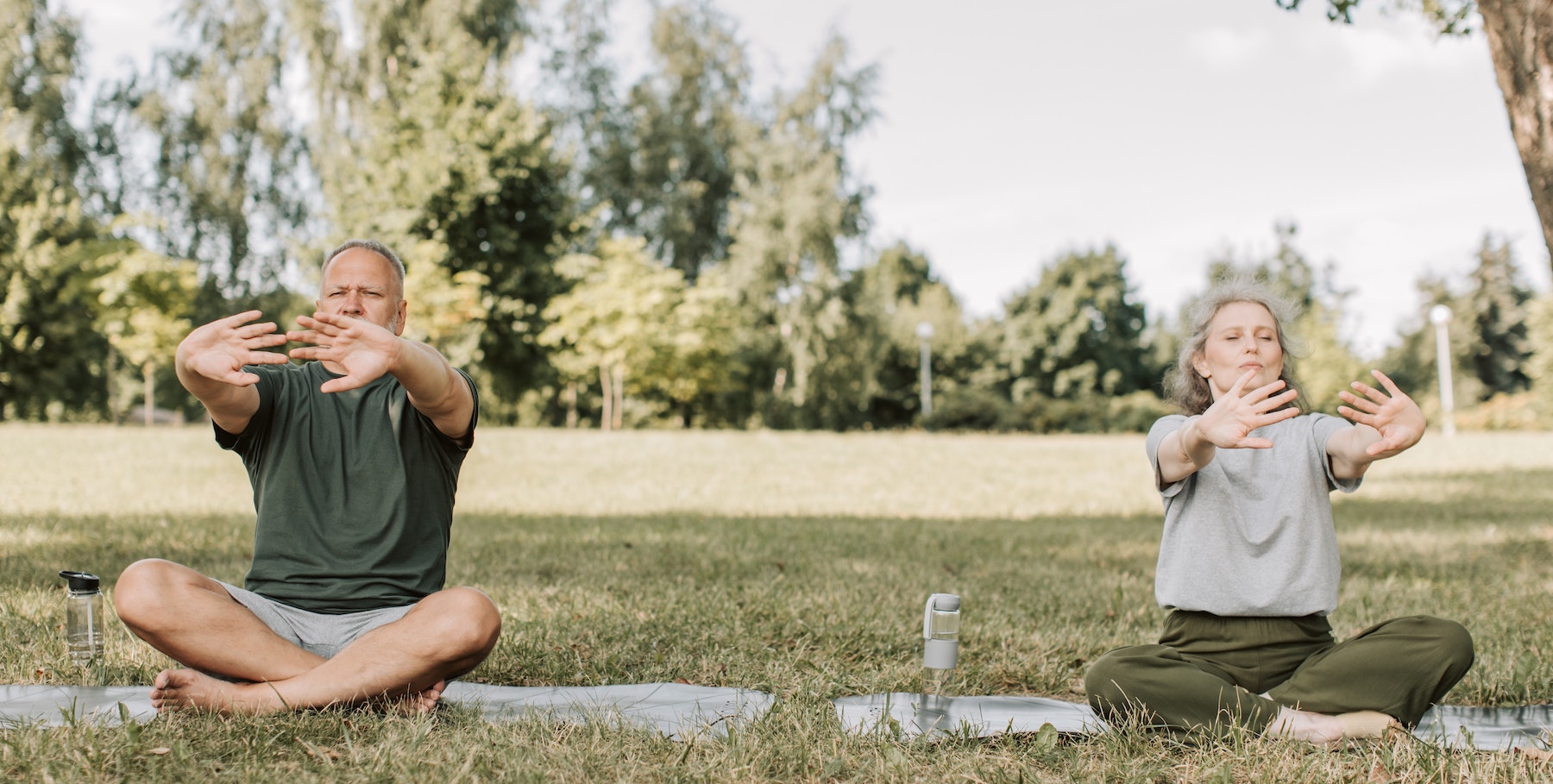What is breathwork?
Breathwork is an active meditation practice that uses conscious breath to promote physical, mental, and emotional healing. Through a variety of breathing techniques, breathwork helps to reduce stress, boost energy, and increase self-awareness. It is an integrative practice that can be used as a tool for self-healing, personal growth, and spiritual exploration.
Different types of breathwork
There is a variety of breathwork techniques that can be used to improve one’s mental and physical health. These practices focus on deep breathing and self-awareness, which aim to promote relaxation and stress relief. There are some elements that most breathing techniques have in common, like teaching practitioners to engage their diaphragm more, rather than the shallow chest-breathing most of us have gotten accustomed to—this is often referred to as belly breathing, diaphragmatic breathing, or abdominal breathing, and can lead to deep relaxation.
Transformational Breathwork
Transformational Breathwork is a type of breathwork that uses conscious, connected breathing to bring about emotional and physical healing.
Clarity Breathwork
Clarity Breathwork uses deep and conscious breathing to help the practitioner gain insight and clarity into their life.

Pranayama Breathwork
Pranayama breathwork is a type of breathwork that focuses on controlled breathing to improve physical and mental health, and engage prana (“life force” in Sanskrit) more actively. It often involves alternate nostril breathing (also referred to as nadi shodhana pranayama, which in Sanskrit means subtle energy clearing breathing technique), and can often be a compimentary practice to Ayurvedic treatments.
Holotropic Breathwork (HB)
This type of breathwork utilizes powerful breathing techniques developed in the 1970s by Christina and Stanislav Grof, who had experimented widely with LSD, to introduce altered states of consciousness without the use of any psychedelics.
Reiki Breathwork
Reiki breathwork utilizes energy healing techniques to help the practitioner access and balance their spiritual energy.
Emotional Freedom Technique (EFT)
Emotional Freedom Technique (EFT) is a type of breathwork that combines breathing techniques with tapping to help the practitioner release emotional blocks.
Quantum Breathwork
Quantum Breathwork is a type of breathwork that uses focused breathing and visualizations to help the practitioner access higher states of consciousness.
Wim Hof breathing
Wim Hof breathing is a type of breathwork that combines hyperventilation and breath holds to help the practitioner access deeper states of relaxation and awareness.
Shamanic breathwork
Shamanic breathwork is a type of breathwork that utilizes the power of breath to access spiritual realms, stay in the present moment, and connect to the divine.
BioDynamic Breathwork
BioDynamic Breathwork is a holistic form of breathwork that is inspired by the work of Peter Levine, Dan Siegel, and Wilhelm Reich, and is particularly focused for trauma release work.
Vivation
Vivation is a type of breathwork that uses breath to help the practitioner release physical and emotional blocks.
Circular breathing
Circular breathing is a technique commonly used by musicians to sustain a continuous tone or phrase without having to pause to take a breath. It is achieved by inhaling through the nose while simultaneously exhaling through the mouth, using the cheeks as a bellows to maintain a steady air flow, but it can also be used to improve athletic performance.
Rebirthing breathwork
Rebirthing breathwork is a type of breathwork that uses connected breathing to help the practitioner access and heal old and unresolved emotional issues.
Full mouth breathing
Full mouth breathing is the “natural” way of inhaling and exhaling, but most of us only breathe this way when we are sleeping or are performing strenuous exercise such as running or weight lifting. In the full mouth method, the practitioner places his or her hands on the belly and takes slow breaths through the nose in order to feel the expansion of the abdomen with each inhalation and the contraction of the abdomen with each exhalation.
This form of breathwork can be practiced alone (if you’re so inclined) or in a group setting led by a facilitator who is trained in the practice. Since it can be somewhat uncomfortable in the beginning, it is best to do it in the company of an experienced practitioner who can assist you and help you overcome any obstacles that may arise during the session.
Closed-mouth breathing (nostril breathing)
Closed-mouth breathing is another popular type of breathwork that is practiced most often in groups under the guidance of a facilitator who is trained in the practice. The process involves taking slow, deep breaths through the nose while the mouth is closed so that no air enters the lungs other than what comes from the nostrils.
This method of breathing takes some getting used to, so it’s best to try it under the supervision of an experienced practitioner who can assist you in overcoming any obstacles that may arise during the process.
Although people may initially experience some discomfort during closed-mouth breathing exercises, this should subside within a few sessions as the body becomes accustomed to the new process.
Which is better? Full- or closed-mouth breathing?
By experiencing both full and closed-mouth breathing exercises, you can determine which technique works best for you so that you can begin to incorporate it into your self-care routine on a regular basis.
The science of breathwork
The evidence for breathwork is still relatively limited, but preliminary research suggests that it may be beneficial for both physical and mental health. Studies have found that breathwork can reduce anxiety and depression, improve sleep, reduce stress, and even increase feelings of relaxation and well-being by regulating the parasympathetic nervous system. It is also thought to help with physical ailments such as asthma, bronchitis, and improves heart rate variability.
Koul published a paper titled A Systematic Review And Meta-Analysis Of Effectiveness Of Breathing Exercises On Blood Pressure Of Patients With Hypertension in 2021 which concluded that breathing techniques can help regulate blood pressure, and there’s a much cited article by Grossman et al published 2001 in The Journal of Human Hypertension which found breathing exercises to be an effective, non-pharmacological modality to reduce blood pressure.
In addition, some research suggests that breathwork can improve cognitive functioning and boost the immune system.
A 2019 study titled Evaluation of Breathworks’ Mindfulness for Stress 8-week course: Effects on depressive symptoms, psychiatric symptoms, affects, self-compassion, and mindfulness facets in Brazilian health professionals also showed that breathwork can help improve the mental health of healthcare professionals. A 2011 review by Lalande et al has shown that Integrative Breathwork Therapy (IBT) might be beneficial for people suffering from anxiety disorders like PTSD. Breathing techniques can be very effective at regulating the fight-or-flight response and instead help you remain calm.
While further research is needed, breathwork appears to be a promising tool for improving overall health and wellbeing.
Risks of practicing breathwork
Breathwork can have some risks, as it can cause a person to become easily overwhelmed and can lead to intense emotions that can be difficult to manage. It can also lead to feelings of hyperventilation, dizziness, and nausea. Additionally, if done improperly, breathwork can lead to hyperventilation and oxygen deprivation, or excessive carbon dioxide exhalation which can impair blood flow to the brain. It is important to work with an experienced practitioner and to go slowly, so that the risks can be minimized.
Cons of Breathwork
1. Uncomfortable Breathing Techniques: While breathwork is designed to induce relaxation, it can also be uncomfortable for some practitioners. This is especially true for those who are new to breathwork, as the breathing techniques can take some time to get used to.
2. Potential Risks: Breathwork can be an intense experience and there are some potential risks associated with it, such as dizziness, nausea, and hyperventilation. It is important to be aware of these potential risks and to consult with a healthcare professional before beginning any type of breathwork.
3. Not Suitable for Everyone: Breathwork is not suitable for everyone, especially those with certain medical conditions or those who are pregnant or breastfeeding. It is important to consult with a healthcare professional before beginning any type of breathwork.
How to get started?
1. Learn the basics: It’s important to understand the fundamentals of breathwork, so take some time to read up on the different forms of breathwork and their benefits.
2. Find a guide: Working with a certified breathwork practitioner, coach, or guide can help you get the most out of your breathwork practice, so seek out someone qualified to work with you.
3. Start practicing: Once you’ve done your research, set aside some time each day to practice breathwork. Start out with a few minutes, and increase the duration as you become more comfortable with the technique.
4. Make it a habit: Breathwork should become a habit, so make sure to schedule breathwork sessions into your daily routine.
5. Be consistent: Consistency is key with any practice, including breathwork. Try to practice at the same time each day so that it becomes a part of your lifestyle.
Questions:
How is breathwork different from meditation?

Breathwork can be practiced as a type of meditation, but it is more active and intentional. Rather than simply sitting in silence, breathwork is a conscious practice of controlling and focusing your breath. It can be done lying down or in a seated position and involves breathing in and out in specific rhythms for a set period of time. Breathwork can be used to help reduce stress, improve focus, and increase energy levels. It can also be used to explore emotions, clear blockages, and create a sense of inner peace and balance.
Is breathwork a spiritual practice?
There are both spiritual and non-spiritual types of breathwork. There are many types of breathwork which are solely practiced as a wellness treatment and for the health benefits they bring.
How much does it cost to learn and practice breathwork?
The cost of learning breathwork will vary depending on the type of breathwork you are interested in and the instructor you choose. Generally, private sessions with a breathwork teacher can range from $50 to $150, while group classes can range from $25 to $50 per session. Additionally, there may be additional costs associated with attending workshops and retreats, which can range from $200 to $1,000 depending on the type and length of the program. Many people opt to begin their breathwork practice on their own by simply looking up information on the internet, which is of course cost free and can, when done responsibly, yield the same health benefits as a structured training course.
